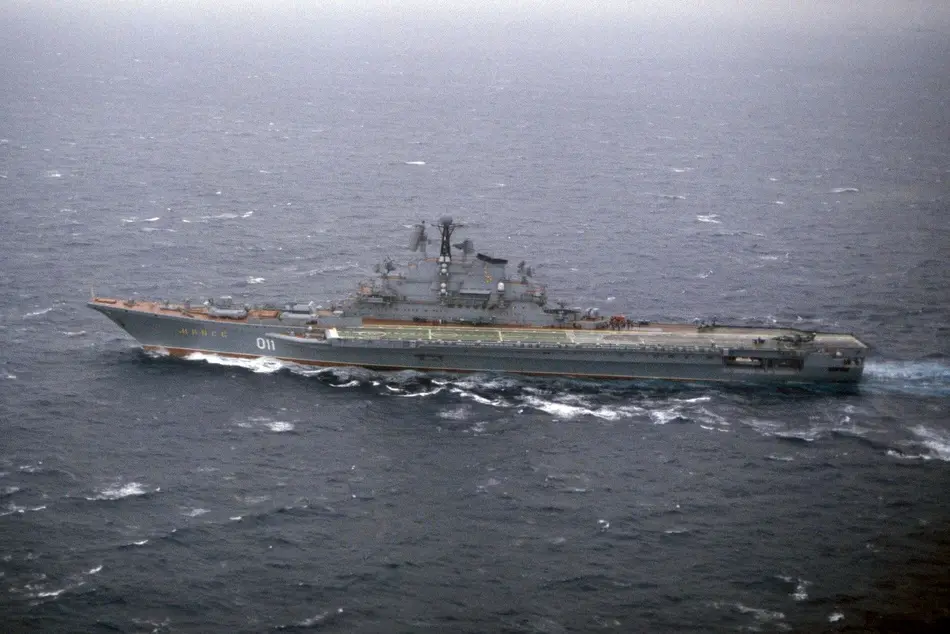Could China launch fighter jets from its theme park aircraft carriers?
Currently, the United States operates eleven aircraft carriers capable of launching fixed-wing aircraft. France, India, Italy and Russia have only one such carrier each, while three other world powers have two.

Currently, the United States operates eleven aircraft carriers capable of launching fixed-wing aircraft. France, India, Italy and Russia have only one such carrier each, while three other world powers have two.
One of them is the United Kingdom, another one is the Chinese military, and the third one is the Chinese entertainment industry.
Two of their massive ships, Kiev and Minsk, are ex-Soviet Kiev class heavy aviation cruisers transformed into tourist attractions. One of them is docked at the Binhai theme park and houses a luxury hotel and a casino. Another one used to be the centerpiece of Minsk World theme park in Shenzhen, but has been towed away for repairs and is set to become a part of Nantong resort in 2022.
That is not counting two mockup Nimitz class carriers in Binzhou and Quingpu, but those are a story for another day.
A history of adoption
While the story of Chinese businessmen buying decommissioned warships for commercial use may seem innocent and straightforward, China has a history of having ulterior motives with its purchases.
The first aircraft carrier the country got its hands on was HMAS Melbourne, a heavily modified Australian light carrier dating back to the 40s. It was sold to Chinese shipbuilding company for scrapping in the mid-80s, but caught the interest of the army, which decided to use it as a jumpstart for their own aircraft carrier program. Melbourne was dismantled and studied, some reports indicating that over a decade had passed before the ship had actually been scrapped.
China’s first actual functioning aircraft carrier was ex-Soviet Kuznetsov class ship Varyag, put on sale by Ukraine in 1992. After inspecting it, the Chinese delegation declined the offer, only for the rusting hulk to be purchased several years later by a Macau-based company. The purpose of the purchase, officially, was for the carrier to become a floating hotel.
It was a cover story. By 2011, Varyag was refurbished, restored and modernized. A year later it was commissioned into Chinese navy as Liaoning. By 2016 it was fully combat-ready.
What about others?
Which brings us to Kiev and Minsk, and their seemingly innocent purpose in Chinese waters. Both ships were well kept, and structure-wise are even in a better state than the rusty Varyag during its acquisition. Both of them are sea-worthy, they have retained their flight decks and even house a large collection of old fighter jets.
Also, China’s aircraft carrier program is in full swing: domestically-built Shandong, very similar to Liaoning, was commissioned in 2019. Two even larger ships – Type 003 and nuclear-powered Type 004 – are under construction as of early 2021.
The rush is understandable: China’s territorial disputes in the seas on its east are near endless. The primary purpose of an aircraft carrier is to project military power – act as a mobile airbase, delivering firepower to a point far from the homeland. Being able to launch large-scale aerial strikes allows a country to intimidate unfriendly neighbors much more effectively, threatening shipping routes, fishing areas and military outposts on remote islands.
Following this logic China could want to reconstruct the two ex-Soviet ships, and put them into service. But would that be possible?
Both Kiev and Minsk currently are just empty shells of themselves: engines, armaments and all the other equipment was removed, to make way for hotel suites, interactive entertainment installations or simply because it was too dangerous or too expensive to be left as is. Restoring the military capability would mean massive investments. But it would surely be cheaper than building a carrier from ground-up, right? Not entirely so.

Aviation problem
Kiev-class heavy aircraft cruisers were capable warships, armed with an array of anti-ship and anti-air missile systems. Their role in the Soviet naval doctrine was that of protecting homeland shores from enemy naval assets, and aircraft those ships operated were just one of several tools to do that.
In addition to utility, reconnaissance and anti-submarine helicopters, the primary aircraft Minsk and Kiev were intended to operate was Yakovlev Yak-38, the Soviet answer to British Harrier jump jet. It was a short take-off and vertical landing (STOVL) strike aircraft with some air-to-air capability. Its replacement – Yak-141 – was supposed to improve on it in every aspect, but never went beyond the prototype stage.
Designed to operate Yak-38s, Kiev and Minsk are equipped with neither a ski-jump nor a provision for a catapult. They could only launch STOVL airplanes, the ones that did not need a boost while taking off from only 53 meters (174 ft) long flight deck.
Meanwhile, China does not have such aircraft: its Shenyang J-15s, reverse-engineered Sukhoi Su-33s, are all designed to operate from Kuznetsov class ships. The prospective FC-31, the 5th generation light fighter jet that may be intended for Chinese carriers, does not have STOVL capability too. The country would need to design an entirely new airplane – one of very rare and extremely complex kind – to operate from those ships.
This does not mean that the task is impossible though. First off, Minsk and Kiev could just become helicopter carriers, without a provision for fixed-wing aircraft. Pretty much any sufficiently large ship can become one.
Also, the conversion of Kiev-class ships into something heavier is not unprecedented. INS Vikramaditya, currently the only operational Indian aircraft carrier, was originally built as Kiev-class Soviet navy vessel Baku. Purchased by India in 2004, it was upgraded with a ski-jump, and now is used to operate MiG-29K fighter jets.
The conversion took 10 years, 2500 tons of steel and was quite unprecedented in its cost though. The hull had to be substantially modified to accommodate an entirely new and larger flight deck, reworked aircraft lift, arrestor cables with their mechanisms, and countless other systems.
Theoretically, Minsk and Kiev could undergo such conversions and be ready to launch J-15s or FC-31s. In practice, such a development seems highly unlikely, and just as in Indian case, would require many years of modification. It is much more likely for China to build new, more capable aircraft carriers instead of investing huge amounts of money into rebuilding old ones. Which means, they will likely remain a tool of entertainment, instead of warfare, for the foreseeable future



